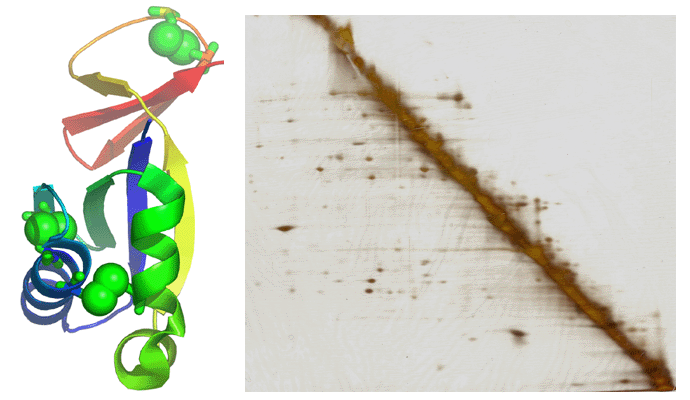Discovery of Thermophiles Using Widespread Disulfide Bonding
|
The cytosolic environment of most well-studied organisms is
chemically reducing. As a result, stabilizing disulfide
bonds are generally absent from cytosolic proteins, though
they are abundant in extracellular proteins, including those that are
secreted and those that reside in the bacterial periplasmic space.
However, this simplistic textbook view of protein disulfide bonding
is apparently violated by certain organisms. Based upon a crystal structure
of a hyperthermophilic protein he determined as a student in 2000, Eric Toth
predicted that certain thermophiles are
able to use disulfide bonding to stabilize their proteins against
extreme conditions. This claim was supported by Parag
Mallick in 2002 using computational approaches, and has since been validated by multiple
subsequent studies. The various studies included: a simple cysteine-counting exercise
(which showed that hyperthermophilic archaea show a clear abundance of
proteins having an even number of cysteine residues), genome-wide sequence-structure
mapping calculations (which showed a striking tendency of cysteine residues to be near other cysteine residues
in these organisms), and 2D oxidized-reduced SDS gels (which showed an abundance of proteins and protein-complexes
held together by disulfide bonds.
The widespread occurrence of disulfide bonds in these organisms helps explain the puzzle of how their proteins
are stabilized under such extreme conditions. It also paints a picture of protein disulfide bonding
and cellular redox state
that is more complex than previously anticipated. Our future efforts aim to exploit the expected
presence of disulfide bonds in proteins from these organisms to boost protein structure prediction algorithms.
|
 |
References:
Toth, E.A., Worby, C., Dixon, J.E., Goedken, E.R., Marqusee, S., and Yeates, T.O. 2000. The Crystal Structure of Adenylosuccinate
Lyase from Pyrobaculum
aerophilum Reveals an
Intracellular Protein with Three Disulfide Bonds. J. Mol. Biol., 301, 433-450.
Mallick, P., Boutz,
D.R., Eisenberg, D., and Yeates, T.O. 2002.
Genomic Evidence that the Intracellular Proteins of Archaeal
Microbes Contain Disulfide Bonds. Proc. Natl. Acad. Sci. USA 99,
9679-9684.
Beeby, M., O'connor, B.D., Ryttersgaard, C.,
Boutz, D.R., Perry, L.J., Yeates,
T.O. 2005. The Genomics of Disulfide Bonding and Protein Stabilization in Thermophiles. PLoS Biol. 3, PLoS Biol. 3, 1549-58.
Boutz, D.R., Cascio, D., Whitelegge, J., Perry, L.J., and Yeates,
T.O. (2007).
Discovery of a thermophilic protein complex
stabilized by topologically interlinked chains.
J. Mol. Biol. 368,
1332-44.
Return to Research Overview
